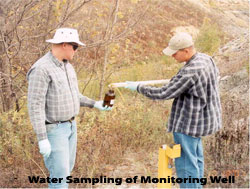Share:
GROUNDWATER QUALITY & TESTING

The quality of groundwater can affect not only our health, but also society and the economy. Groundwater contamination can adversely affect property values, the image of a community, economic development, and the overall quality of life we all share. Clean water at reasonable cost is essential and in many parts of the country, groundwater is the only economical water source available. Once groundwater has been contaminated, it is usually very difficult and costly to clean. Even small contamination sites often cost many thousands of dollars to cleanup. The quality of water from private water supplies, such as those from wells at individual homes, is not regulated. It is the responsibility of the well owner to ensure a safe drinking water supply. Although there are a few requirements for water quality testing and monitoring of private wells (i.e., in some areas, testing is required at the time of property transfer), it is recommended that all well owners have their water tested periodically. While “complete” drinking water analyses can be expensive and are generally unnecessary for the private well owner, it is recommended that private water supplies be tested routinely for common contaminants including total coliform bacteria, nitrates, and lead. These contaminants can occur in well water due to agricultural activity, septic system use, household chemical use/ disposal, age of the plumbing or industrial activity. The frequency of water testing and the contaminants to test for depend on factors such as the potential sources of pollution and the type of well. Another consideration is ensuring that the private well complies with proper well construction standards.
A water’s taste, smell, or color is not necessarily an indicator of water quality. Many of the most hazardous contaminants are undetectable to the senses. The only way to detect most pollutants is by testing.
Before hydraulic fracturing operations begin in a new area, American Petroleum Institute guidance (API – HF1) recommends that a baseline assessment program which includes the sampling of nearby water wells be conducted prior to hydraulic fracturing operations. Fresh water wells should also be sampled following hydraulic fracturing operations. At least one state (Colorado) requires the sampling of certain water wells in various areas of the state as part of their regulatory program. Another state (Pennsylvania) has regulations that presumptively place the burden of proof on any oil and gas company to demonstrate that they have not caused deterioration of the quality of groundwater used for drinking water purposes in the vicinity of oil and gas wells in the event of a contamination complaint.
In order to obtain valid results from sampling it is important to follow proper sampling and analysis protocols. Contact a state or EPA certified laboratory for sampling containers and instructions. Proper protocols may include:
- using appropriate containers and seals,
- purging of the well prior to sample capture,
- collection at points before water treatment equipment,
- following sample container filling procedures;
- following storage and holding time requirements;
- utilizing appropriate analysis methods; and
- following appropriate quality control/ quality assurance protocols
Sampling should be conducted by someone familiar with sampling procedures. Analyses should be conducted by an accredited laboratory using appropriate analysis methods. You may be able to obtain a list of qualified laboratories by contacting your local Health Department, State Water Quality Agency shown on the Regulations By State page or County Extension Agent.
It is important for the landowner to have an oil and gas operational sampling and analysis of their groundwater conducted by a professional for constituents that may provide a reasonable baseline for post fracturing analysis. The following is a good basic list of constituents that should be considered for analysis prior to oil & gas operations.
- Major cations and anions
- pH
- Specific Conductance
- Total Dissolved Solids
- Benzene, Toluene, Ethyl benzene, Xylene (BTEX)/ Diesel Range Organics (DRO)/ Gasoline Range Organics (GRO)
- Total Petroleum Hydrocarbons or Oil & Grease (HEM)
- Arsenic
- Barium
- Calcium
- Chromium
- Iron
- Magnesium
- Selenium
- Boron
- Sodium
- Chloride
- Potassium
- Bicarbonate
- Dissolved Methane
Once hydraulic fracturing has taken place and a record of the actual chemicals used is available, it would be advisable to consider having a sampling and analysis conducted on the groundwater for the chemicals shown on the record that match those listed above or those that are by-products, reaction products or daughter products of those listed above. This is important because many of the chemicals used in hydraulic fracturing will be degraded, oxidized, or otherwise modified during the fracturing process. Thus, simply looking for the chemicals on the list shown above may not yield enough information for a comparative analysis. However, to minimize costs for the landowner, an alternative analysis should be conducted for at least TDS and Dissolved Methane. An increase in the concentration of either of these constituents could indicate that further, more complete sampling and analysis should be conducted.
Important: Only a trained professional such as a Toxicologist or a Physician can tell you if your water is safe to consume. You should not use the information obtained from this website or any other website to make decisions regarding the safety or drinkability of your water.